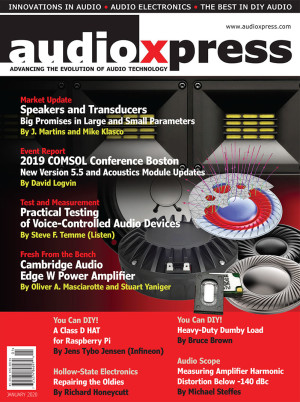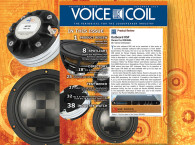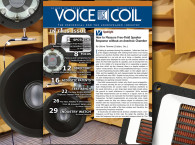 To kick off 2020 in the best possible way, this edition includes a Market Update about Speakers and Transducers where we address new trends, from new diaphragm materials for loudspeakers to woofers, tweeters, and compression drivers, to microspeakers, MEMS, and even drivers for headphones. And we share some vital market data that shows how speaker technology and components continue to be at the core of a thriving industry.
To kick off 2020 in the best possible way, this edition includes a Market Update about Speakers and Transducers where we address new trends, from new diaphragm materials for loudspeakers to woofers, tweeters, and compression drivers, to microspeakers, MEMS, and even drivers for headphones. And we share some vital market data that shows how speaker technology and components continue to be at the core of a thriving industry.
This joint effort by J. Martins and Mike Klasco is the first of what is intended as an annual tradition, reviewing the leading marketing and technology trends in the professional audio, studio, high-end and consumer spaces in terms of speaker designs and technologies, combined with an overview of related product introductions of the past 12 months.
Another highlight is the event report by David Logvin about the 2019 COMSOL Conference in Boston, MA. In his report for audioXpress, Logvin shares what he witnessed at this important three-day event, where COMSOL unveiled its latest Multiphysics 5.5 Release. The article explores the latest tools available for acoustics simulation, which help explain the increasing adoption of COMSOL Multiphysics simulation software throughout the audio and acoustics world.
Moving on to our reviews, Oliver Masciarotte and Stuart Yaniger, tested Cambridge Audio’s Edge series power amplifier, the Edge W, which the British manufacturer introduced in 2018 as part of its 50th anniversary celebrations. audioXpress submitted this design, which claimed to be the culmination of the brand’s audio engineering expertise, to extensive listening and measurement sessions. Masciarotte confirmed its qualities in the living room, while Yaniger discovered some very smart engineering with his inside look and measurements.
For this edition, Michael Steffes discusses "Measuring Amplifier Harmonic Distortion Below -140 dBc" in his Audio Scope column. As he explains, at lower frequencies than 100 kHz higher speed op-amps and fully differential amplifiers (FDAs) become essentially unmeasurable using typical passive filter and spectrum analyzer techniques. Recognizing that the spurious add as little voltage sine waves, an innovative technique was developed to allow measurements below even -140 dBc to be made from 1 kHz to 1 MHz.
In our Test & Measurement feature, Steve F. Temme (Listen), discusses tools and techniques that can be used to accurately measure the audio performance of voice-controlled and connected devices under the many various real-world conditions they may be used. The article covers basic acoustic measurements such as frequency and distortion response, which have always been carried out on conventional wired systems, and the more complex real-world tests that apply specifically to voice-activated devices, along with the techniques and standards that may be used.
From a practical perspective, Jens Tybo Jensen (Head of Marketing and Applications Engineering for Class D Audio, Infineon Denmark), shares a great suggestion for a new affordable high-end 2 x 40 W Class D audio amplifier implemented with a Hardware Attached on Top (HAT) board to connect onto a Raspberry Pi Zero platform, creating a solution ideally suited for DIY audio projects. Time to try it on a new home speaker design!
In another DIY article, Bruce Brown writes about a heavy-duty dumby load that he built himself. Regular audioXpress readers might know that Brown restores vintage tube equipment, as well as select transistor stuff and he says there are a number of essential tools needed for evaluating and testing audio equipment. These include an oscilloscope, a good voltmeter, an audio generator (sine, square, and triangle waveforms), and a serious dumby (or dummy) load.
Next, Richard Honeycutt dives into vital considerations and knowledge for repairing old tube equipment. In his Hollow-State Electronics article, Honeycutt shares several valuable tips for anyone facing the challenges of repairing antique radios, or any other valuable piece of tube gear.
 All this, and much more, in another great edition of audioXpress, now available online, and on its way to those who subscribe to the print edition. To read this edition now, you will need to subscribe to audioXpress. Print and/or Digital subscriptions are available. Subscribe to the digital online version and get immediate access at: www.audioxpress.com/page/audioXpress-Subscription-Services.html
All this, and much more, in another great edition of audioXpress, now available online, and on its way to those who subscribe to the print edition. To read this edition now, you will need to subscribe to audioXpress. Print and/or Digital subscriptions are available. Subscribe to the digital online version and get immediate access at: www.audioxpress.com/page/audioXpress-Subscription-Services.html
If you wish to buy a single printed issue or the complete audioXpress archive on USB, from 2000 to 2019 (yes, including the latest issue), just visit our online shop at www.cc-webshop.com.
Don't miss out, get your copy of audioXpress right now at www.gotomyxpress.com

- on Magazine News
- News
Kick Off Another Exciting Year for Audio Technology with audioXpress!
December 11 2019, 17:10
audioXpress January 2020 is now available in print and download! To start 2020 in the best possible way, this edition includes a Market Update about Speakers and Transducers, followed by a report of the COMSOL Boston Conference where the latest Multiphysics 5.5 Release was unveiled, a great review of the Cambridge Audio Edge W amplifier, and an in-depth article in which Steve Temme discusses tools and techniques to accurately measure voice-controlled and connected devices. Plus many more great theory articles and practical knowledge shared by audioXpress experts.





